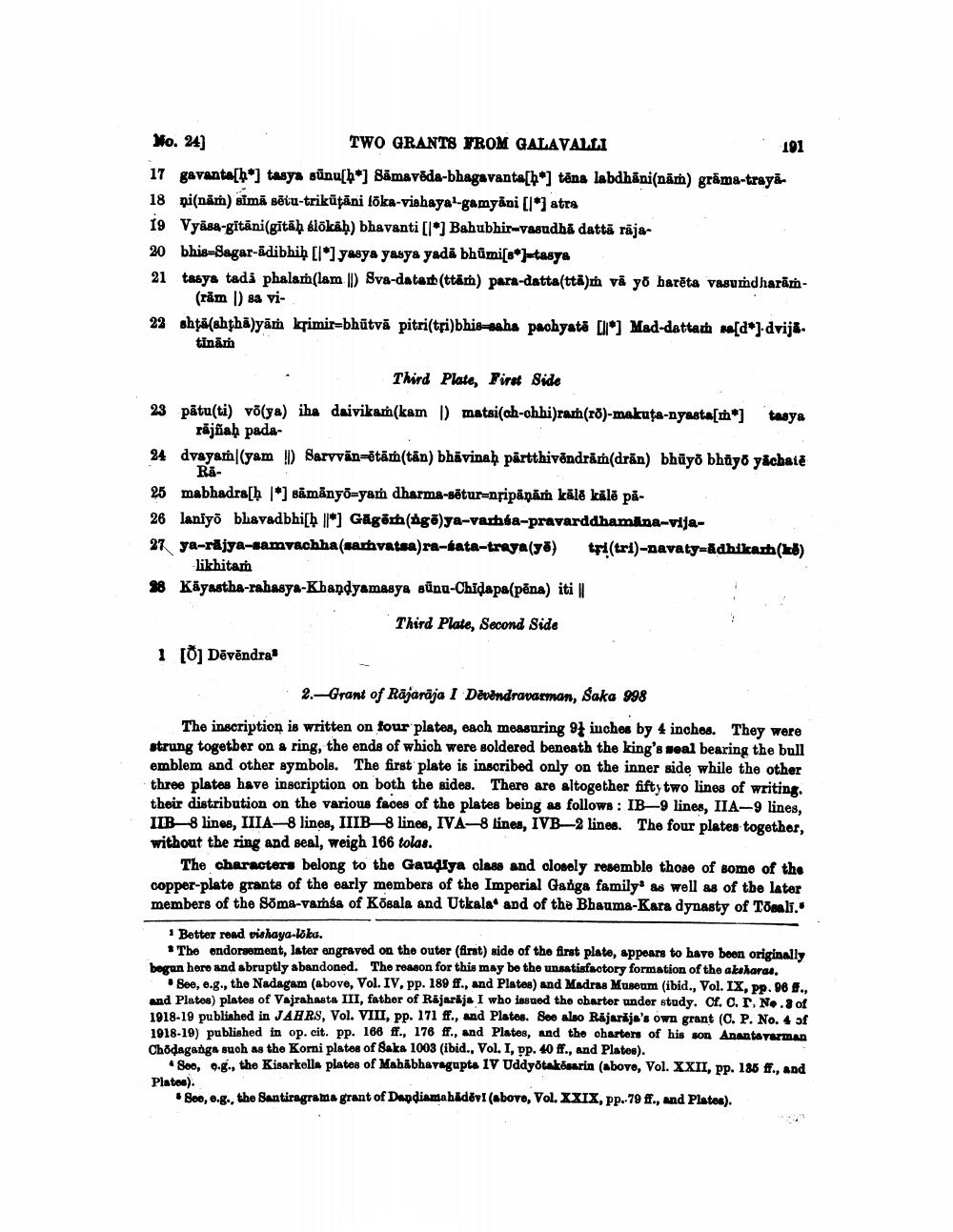________________
101
No. 24]
TWO GRANTS FROM GALAVALLI 17 gavanta[h*) tasya sūnu[b*) Sāmavěda-bhagavanta[h*] tâna labdhāni(nām) grāma-traya18 pi(näm) simā sētu-trikūtāni loka-vishaya--gamyäni [1“) atra 19 Vyasa-gitāni(gītāḥ slokah) bhavanti [l*) Bahubhir-Vasudhā dattā rāja20 bhis-Sagar-ādibhiḥ [lyasya yasya yada bhūmi[b*J-tasya 21 tasya tada phalam(lam 1) Sva-datam (ttäm) para-datta(ttä)m vā yo barēta vasundharam
(rām 1) sa vi22 shtā(shtha)yām krimir=bhūtvā pitri(tri)bhis-saha pachyată [ll] Mad-dattarh [d].dvija.
tinām
Third Plate, First Side 23 pātu(ti) võ(ya) iha daivikam(kam 1 matai(ah-chhi)ram(17)-makața-nyasta[m] tasya
rājfiah pada24 dvayam|(yam !) Sarvvān=ētām(tān) bhāvinab pärtthivöndrām(drān) bhūyo bhayo yachatë
Rā25 mabhadra[h 1*) sämányo=yam dharma-sētur=nfipāņām kala kalë pā26 laniyo bhavadbhish ||*] Gagönh (ngo)ya-vaxtasa-pravarddhamina-vija27 ya-rajya-samvachha(samvatsa)ra-sata-traya(yo) tfi(tri)-navaty-adhikar (18)
likhitam 28 Käyastha-rahasya-Kbandyamasya sūnu-Chidapa(pēna) iti |
Third Plate, Second Side 1 [/] Dēvēndra
2.- Grant of Rājarāja 1 Devendravarman, Saka 998 The inscription is written on four plates, each measuring 94 inches by 4 inchos. They were strung together on a ring, the ends of which were soldered beneath the king's weal bearing the bull emblem and other symbols. The first plate is inscribed only on the inner side while the other three plates have inscription on both the sides. There are altogether fiftytwo lines of writing. their distribution on the various faces of the plates being as follows: IB-9 lines, IIA-9 lines, IIB-8 lines, IIIA—8 lines, IIIB-8 lines, IVA-8 lines, IVB-2 lines. The four plates-together, without the ring and seal, weigh 166 tolas.
The characters belong to the Gandiya class and closely resemble those of some of the copper-plate grants of the early members of the Imperial Ganga family as well as of the later members of the Soma-vamsa of Kösala and Utkala and of the Bhauma-Kara dynasty of Tonali.
1 Better read vishaya-loku.
* The endorsement, later engraved on the outer (first) side of the first plate, appears to have been originally began here and abruptly abandoned. The reason for this may be the unsatisfactory formation of the akaharas.
See, e.g., the Nadagam (above, Vol. IV. pp. 189 ff., and Plates) and Madras Museum (ibid., Vol. IX, PP. 98 8., and Plates) plates of Vajrahasta III, father of Räjarija I who issued the obarter under study, or, O. C, No. 3 of 1918.19 published in JAHRS, Vol. VIII, pp. 171 ff., and Platos. See also Rajarija's own grant (C. P. No. 4 of 1918-19) published in op. cit. pp. 166 ff., 176 ff., and Plates, and the charters of his son Anantavarman Chodaganga such as the Korni plates of Baka 1003 (ibid., Vol. I, pp. 40 ff., and Plates).
Soo, 9.g., the Kisarkelle plates of Mahabhavagupta IV Uddyotakoarin (abovo, Vol. XXII, pp. 186 ff., and Plates).
Soo, .g., the Santiragrama grant of Depdiamabldēvi (abovo, Vol. XXIX, pp.70 ff., and Platea).




